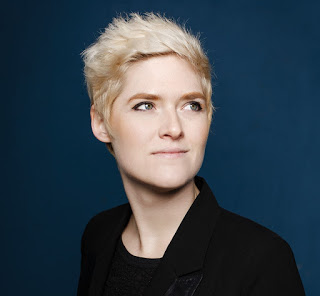#FUSEdesign
Designing Calm Technology

Amber Case
FUSE 2017 presenter Amber Case, author of Calm Technology: Designing for the Next Generation of Devices, studies the interaction between humans and computers and how our relationship with information is changing the way cultures think, act and understand their worlds.
As a preview to her presentation, Amber shares her insights on the how calm technology helps us to be more human.
Peggy L. Bieniek, ABC: What is calm technology, and from where did this term originate?
Amber Case: We live in an era of interruptive technology. The world beeps at us incessantly. We are asked to update the software on our Apple TVs before we watch a show, not right before we turn the device off. There are ways to deal with this technology overload. We need a calm technology, not an interruptive one.
Amber Case: We live in an era of interruptive technology. The world beeps at us incessantly. We are asked to update the software on our Apple TVs before we watch a show, not right before we turn the device off. There are ways to deal with this technology overload. We need a calm technology, not an interruptive one.
A Calm Technology describes products that are there when we need it, not when we don't, where our devices recede into the background and allow us to be human.
The terms 'calm technology' were coined in 1995 by PARC Researchers Mark Weiser and John Seely Brown in reaction to the increasing complexities that information technologies were creating. They felt that the promise of computing systems was that they might 'simplify complexities, not introduce new ones.'
PB: What is the importance of calm technology in the global marketplace?
AC: Calm Technology can help us understand what we need to implement to handle the increasing complexity of the world.
AC: Calm Technology can help us understand what we need to implement to handle the increasing complexity of the world.
Humans do things that technology is bad at: customer service, warm embraces, and problem solving when something goes wrong with technology. Humans are natural curators. They understand context. No matter what, all loops should have a human at the end to check for accuracy. Otherwise we can get stuck in very unfortunate circumstances of automation. Need we bring back the movie WarGames?
PB: How do consumers and brands benefit by calm technology?
AC: A great technology gets out of the way and lets us live our lives. It recedes into the background when unneeded and appears when it does. It's important to bring this concept back in an era that will have an estimated 50 billion devices by 2020.
AC: A great technology gets out of the way and lets us live our lives. It recedes into the background when unneeded and appears when it does. It's important to bring this concept back in an era that will have an estimated 50 billion devices by 2020.
The first principle is this: Technology shouldn't require all of our attention, just some of it, and only when necessary.
Old systems and bad interfaces will plague us if we don't learn how to design for the long term. By writing code that's small instead of large, and making simple systems rather than complex ones, we can begin to design technology that gets out of our way.
How many times have you been on hold with an automated phone tree? This kind of behavior turns humans into machines. A similar thing happens when we try to put humanness into technology. We end up with products that get us stuck in places, look and act creepy, or have other unwanted characteristics.
PB: What are some great examples of companies using calm technology to enhance our lives?
AC: Google is clever because it connects human information to other humans. Invisible search engine bots index billions of pages made by hand. It does a great job managing search results, but it doesn't make the final decision for us. Instead, it gives us a sheet of possible results. It is up to us as humans to make our choices. We are the ones with the context. This is why Google removed the 'I'm feeling lucky' button. Humans choose from a small list. Machines cull down a large list. This is a good human-machine symbiosis.
AC: Google is clever because it connects human information to other humans. Invisible search engine bots index billions of pages made by hand. It does a great job managing search results, but it doesn't make the final decision for us. Instead, it gives us a sheet of possible results. It is up to us as humans to make our choices. We are the ones with the context. This is why Google removed the 'I'm feeling lucky' button. Humans choose from a small list. Machines cull down a large list. This is a good human-machine symbiosis.
The Roomba vacuum cleaner communicates only in melodies and chirps. The cleaner emits a happy chirp when it is done cleaning, and a sad chirp when it is stuck. Because it is small and cute and doesn't continue to do work when it is stuck, it is a non-scary device. It waits for human help rather than trying to do everything itself. The chirp is easy to understand. It doesn't need to be translated into many languages. It conveys the information with a light and a tone, and it is approachable enough that cats enjoy riding on it in YouTube videos!
The LUMOBack Smart Posture Sensor is a device you wear around your waist. It monitors the angle of your back and buzzes you when you exhibit poor posture.
PB: What do you see as the next phase in the interaction of humans and computers?
AC: We have a very large capacity for attention, but often times we design products that only work with our visual sense, and these require us to pay all of our attention to them. As you move away from the sense right in front of you, you can get other senses. Touch, peripheral vision, and sound! We can do so much when we make use of these additional senses. It's a way to get the same amount of information across with the least amount of attention. Think of it as compressing information into another sense!
AC: We have a very large capacity for attention, but often times we design products that only work with our visual sense, and these require us to pay all of our attention to them. As you move away from the sense right in front of you, you can get other senses. Touch, peripheral vision, and sound! We can do so much when we make use of these additional senses. It's a way to get the same amount of information across with the least amount of attention. Think of it as compressing information into another sense!
Computing at this point will have reached a resource limitation as well. Bandwidth will be an issue, as more and more applications rely on the far vs. the near. Video streaming applications like Netflix will see their bandwidth costs soar and consider various solutions. Connectivity is not built like electricity. It's not as reliable, and that's going to become a larger problem!
PB: What will people gain from attending your conference presentation?
AC: Attendees will learn how our devices take advantage of location, proximity and haptics to help improve our lives instead of get in the way. They'll also learn how to determine the minimum amount of technology to solve the problem.
AC: Attendees will learn how our devices take advantage of location, proximity and haptics to help improve our lives instead of get in the way. They'll also learn how to determine the minimum amount of technology to solve the problem.
Want to hear more from Amber? Join us at FUSE 2017. Learn, network and share best practices with the most influential leaders in brand, design and marketing. Stay connected at #FUSEdesign.
Brilliance@Work profile originally published on www.starrybluebrilliance.com
Peggy L. Bieniek, ABC is an Accredited Business Communicator specializing in
corporate communication best practices. Connect with Peggy on
LinkedIn, Twitter, Google+, and at www.starrybluebrilliance.com.

